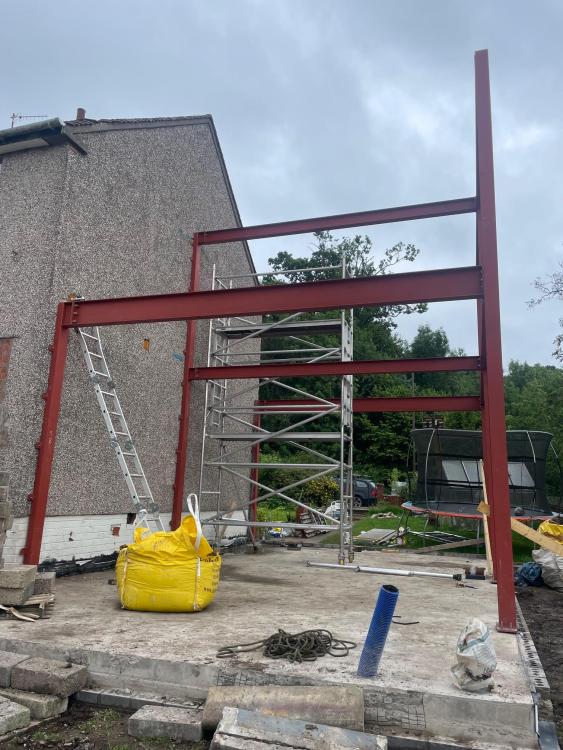Leaderboard
Popular Content
Showing content with the highest reputation on 07/30/24 in all areas
-
Hello all. I know that a lot of folk talk about using D4 glue but this can lead to trouble. The designation D4 relates to the durability of the glue..durability is related to for simplicity the weather exposure.. you can buy D4 from say B & Q, Tool Station, Screwfix and loads of other places. Now I'm fine if you want to use "D4" that is bandied about on BH for sticking some non structural floor boards together. I'm not OK about you using this sole designation D4 (durability) in a stuctural application. A Tesco / Asda etc plastic bag is durable (probably deserves a D4 rating) for lying for years at the side of the road but it's not structurally strong! Glulam beams for example are bonded together with a structural glue that conforms to for example BS EN 301 which deals with glues that have structural stength AND the durability rating which is D1, 2, 3 & 4. Why would you not want to use a glue with both a structural and durability rating that the Glulam folk use? A structural glue requires both stength and durability. Structural glues tend to be resin based.. like old fashioned Araldite that your Mum and Dad used for fixing their glasses... Cascamite structural glue does the job and has both a structural and durability rating. Please folks can we stop recomending D4 when we are discussing bonding structural components.4 points
-
To add a bit. I wrote this in response to a previous post by @Jawbkk who is thinking about fixing some floor joists that have had notches and holes drilled in them. One solution is to plate the joists up with ply. Simplistically the loads need to get into the ply.. round the notches and holes drilled for the electric cables and back into the solid timber. But if you use screws / nails etc then you need many and you can't get enough adequate spacing and edge distance for the nails etc. Also the more nails / scews you use the more risk you run in terms of damaging the already weakened timber. By using a structural glue you transfer the loads over a much wider area. You often just need a few screws to clamp the timber while the glue takes up. To check this type of timber joint if the right glue is used the SE now knows that the glue is stronger than the native timber. Then the SE checks not least what is called the rolling shear in the ply wood. This is the check to make sure that the diffferent layers of ply don't separate. The ply layers are bonded with a structural glue so why use a potentially inferior glue between the ply and the native timber? With a fair wind it then all falls into place and you have a sound solution.3 points
-
Was speaking to a neighbour a few weeks ago and he was sure that when the drains were laid in the village where our site is, about 20 years or so ago, that a spur was put into our land. Had someone out today with a camera and they confirmed that this is in fact the case. Main drain is about 2.5m to invert and therefore should be able to easily fit drains to the office/store that is going in the back of the garden with plenty of fall to the drain. Saved us a good few thousand I think. I had budgeted 5K or so to get the connection. White line on road shows where it runs into the plot.2 points
-
It looks like an unused sewer. well built and in good condition. Have you dared to examine the nature of the deposits? If you project the pipe directions you should find other manholes or likely connections to buildings. then you can pour water in and maybe see where it goes. I would certainly not mess with it. Is it a problem in any way?2 points
-
If you go electric, don’t get talked into an electric boiler. Some plumbers seem to like them, but really they’re the most totally pointless things ever made. Electric resistance heating should be kept simple - immersion heater and electric radiators, far less to go wrong2 points
-
Hey all I have finished the raft slab, underbuild and steel frame. About to start the joinery which is where I suspect I will need to ask questions! I had to get a build over permit from Scottish Water so if anyone has any similar issues with drainage assets within build footprint I can offer some advise or info on how my appeal process went (also a civil and structural engineer which helped!). It took a year but I got approval in the end. Doing all the work myself with the help of family and friends. Some pictures of progress to date. Taken a year to get this far from first breaking ground. A lot of digging, some type 1 compaction, even more rebar tying and a couple of massive concrete pours later! Then 3 days of craziness and a fun using a 12m tellhandler to install the steel frame here I am.... awaiting delivery of timber. Suddenly it all seems real and definitely past the point of no return. The extension includes changes to the exitsing which I have been doing as I go. New stairs into loft and loft conversion. Removed some walls and moved the back door. There will be 3 slappings through the existing gable wall into the extension, one at each level. Can't say I am looking forward to doing those. Looking forward to being part of the community. Cheers Hannah1 point
-
My lastest one is a Kaiweets KT360. Looks like a Chinese knock-off DeWalt, but works well. That battery lasts for ages, but still worth getting a spare.1 point
-
If by decorative you mean rounded stones, they provide zero load bearing and just slide about.1 point
-
The Myson one you can set different temperatures for different times if you need, plus you can alter the water flow for heating and cooling, above or below (cooling) the fan is activated. With temperature and time program if you set to night you set the Mac speed the fan runs during night hours. I have mine set to 23 all the time, and it tries to manage that room temp with the water it's given, warm or cool.1 point
-
70mm PIR between studs and 50mm over the studs on the external side. All fastened with tube washers. Should give me a u value of 0.17 W/m2K Thanks again P1 point
-
from condition looks like grey water. Can you put hosepipe into a downpipe connection and see ?1 point
-
Tried that last week as I too heard they were good at customer service but our experience was awful! Especially when the parents were logged as vulnerable. Several days with no one calling back, even when they said they would. I was ringing daily but it took till Friday evening for someone to actually take control of this (from initial call on Monday morning) and get things moving. I like Octopus but they did not do a good job dealing withthis. Even if it turns out not to be their meter causing the problem; they should have contacted us sooner. But i guess all companies can drop the ball occasionally. 🤔1 point
-
Yeah, I think this is a problem with modern meters - they don't seem to support the old economy seven thing well or at all. I think I would get the electrician back to wire the off peak to the standard supply and install one or more timeswitches for the immersion and storage heater. That way you'll be future proof and you don't have to bang your head against the wall trying to get Octopus to retrace their steps. If they have OK internet, I might make those timeswitches Heatmiser ones and add a controller box so you can control them with a mobile app - but you may think that's a step/expense too far.1 point
-
+1 with @ProDave, bloody smart meters, I would not have one. They should be called dumb meters not smart 🤷♂️1 point
-
I've got the SO4CG, it's a reasonable bit of kit for the money. Aftersales/service sorted me out a warranty replacement when I dropped it and it went out of whack...1 point
-
I've kept a spreadsheet ^^. Ignoring tools, the unit, services, things I bought but never used, and factoring in what I'll need for the finish coat, I'm at about £4500, making the straw less than 10% of the total build cost. Other big-ticket categories - about a quarter was wood: OSB, 2x4, 2x6, 2x8, floorboards, ceiling cladding, that kind of thing. I was buying a lot of that piecemeal, due to limited storage, so I also paid a fair bit out for delivery, and used what I had fairly inefficiently. Could probably get this down a fair bit with better planning. I already had the doors, but spent ~£500 on windows-that-got-used. Honestly, I'm not very happy with the doors, but won't think about a replacement until after everything else is done. Might be another £1000-2000 if I went for something with a big double-glazed panel on the side - it's a ~1.3M wide gap that needs filling. It's taken a long time, but I've not actually put a huge number of labour hours into it. I've not tracked that closely, but the rendering has been ~20x6hr sessions so far, for instance. At £25/hr that'd be a nominal £3K. Doing load-bearing straw like this swaps out a lot of technological wizardry in favour of brute-force labour like that ^^. If I were to do it again, especially at a larger scale, I'd probably be thinking about straw SIP stuff instead, and it seems like the direction of travel is generally that way. I found https://www.thelaststraw.org/panel-fever/ a very interesting read on that front.1 point
-
I’ve had the cooling running all day at flow temperature 15c and my 3 myson Ivector’s have kept the bedrooms at 21c all day. It’s hit 30c and still is 27c outside temperature. No condensation on the pipe work inside humidity 48, downstairs has just hit 24.5c so I’m happy at the moment that I can get away with not insulating my pipe work.1 point
-
I saved money by using a pile company which was owned by a structural engineer, so the design was included. There was a huge price variation so get 3 quotes. Also, you will might have to think about SuDS as a planning condition, if there’s been flooding nearby. It’s a whole new rabbit hole.1 point
-
>>> we do like to challenge the normal ways of doing things to save both time and money Nothing wrong with that, but then it's even more important that the detail is nailed down and you're on top of it. Maybe the key question to ask the architect and builders is 'have you ever done this kind of class Q on a steel frame before. If so, what EPC and air change rates did it get? How did you handle the thermal breaks? What were the challenges and how did you overcome them?' If you get the answer 'no' and/or baffled faces, then pass. If they get out their pencil to sketch the solutions they've figured out before, then listen and be ready to get your wallet / contract signing pen out.1 point
-
well, the HA actually turned off the cooling as dew point rose to 18 (my rule is dew point +2) As the slab was still sitting at 19 i decided to run it at 12C flow temp for 2 hours just to see a worst case example. The unlagged pipework in plantroom (on the todo list) was dripping as was the underfloor manifold, at least the metal parts. BUT the fan coils were fantastically cool, basically aircon cool. The pipework feeding them is run through the pozi's which are stuffed full off insulation but im still worried about condensation on them. For the little extra cost id definitely pipe them fully insulated next time. After an hour you could feel the cool on the ground floor. was 30c outside and 21 in the house with bifolds open. I'm going to lag the manifold and supply pipework today and let it go all day at 12. Used 8 KWH of energy at the ASHP to provide the cooling, with 30 kwh of solar generated was free. Also let this 12c flow throught the MVHR intake cooling battery which has a built in condensation trap, not really sure how much of a difference it made really.1 point
-
1 point



.thumb.jpg.0133caf719fe3be7f5ab14f8bfc328d7.jpg)
.thumb.jpg.2b324c17ac4bdf9468a46adaa28d1a1b.jpg)
.thumb.jpg.e0642fd46c0c69ba383062a9534b3368.jpg)
.thumb.jpg.e8db1d8e2278116585a508158de29017.jpg)
.thumb.jpg.5dfb422f2bc9aff0db331221d3f56971.jpg)
.thumb.jpg.c026cc47986213b4bbedb7ee3a475292.jpg)
.thumb.jpg.b82ae88ffb5e8ad91cebae7db8d1d076.jpg)
.thumb.jpg.03948513961f6a441c738d2719082300.jpg)






